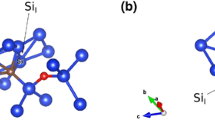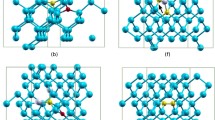Abstract.
In this work we present a detailed investigation of native point defects energetics in cubic SiC, using state-of-the-art first principles computational method. We find that, the carbon vacancy is the dominant defect in p-type SiC, regardless the growth conditions. Silicon and carbon antisites are the most common defects in n-type material in Si-rich and C-rich conditions respectively. Interstitial defects and silicon vacancy are less favorite from the energetic point of view. The silicon vacancy tends to transform into a carbon vacancy-antisite complex and the carbon interstitial atom prefers to pair to a carbon antisite. The dumbbell structure is the lowest-energy configuration for the isolated carbon interstitial defect, and the tetrahedral interstitial silicon is a stable structure in p-type and intrinsic conditions, while in n-type material the dumbbell configuration is the stable one. Our results suggest that, in samples grown in Si-rich stoichiometric conditions, native defects are a source of n-doping and of compositional unbalance of nominally intrinsic SiC, in accord with experimental evidence.
Similar content being viewed by others
References
K.L. More, J. Ryu, C.H. Carter, J. Bentley, R.F. Davis, Cryst. Lattice Defects Amorphous Mater. 12, 243 (1985)
H.J. Kim, R.F. Davis, J. Electrochem. Soc. 133, 2350 (1986)
A. Zywietz, J. Furthmüller, F. Bechstedt, Phys. Rev. B 59, 15166 (1999)
L. Torpo, R.M. Nieminen, K.E. Laasonen, S. Pöykkö, Appl. Phys. Lett. 74, 221 (1999)
L. Torpo, S. Pöykkö, R.M. Nieminen, Phys. Rev. B 57, 6243 (1998)
F. Gao, E.J. Bylaska, W.J. Weber, R. Corrales, Phys. Rev. B 64, 245208 (2001)
M. Bockstedte, M. Heid, O. Pankratov, Phys. Rev. B 67 193102 (2003)
Y. Li, P.J. Lin-Chung, Phys. Rev. B 36, 1130 (1987)
D.N. Talwar, Z.C. Feng, Phys. Rev. B 44, 3191 (1991)
C. Wang, J. Bernholc, R.F. Davis, Phys. Rev. B 38, 12752 (1988)
A. Mattauch, M. Bockstedte, O. Pankratov, Mater. Sci. Forum. 353-356, 353 (2001)
M. Bockstedte, M. Heid, A. Mattausch, O. Pankratov, Mater. Sci. Forum. 389-393, 471 (2002)
A. Mattausch, M. Bockstedte, O. Pankratov, Mater. Sci. Forum. 389-393, 481 (2002)
M. Bockstedte, A. Mattausch, O. Pankratov, Phys. Rev. B 68, 205201 (2003)
S.B. Zhang, J.E. Northrup, Phys. Rev. Lett. 67, 2339 (1991)
G. Makov, M.C. Payne, Phys. Rev. B 51, 4014 (1995)
J.P. Perdew, A. Zunger, Phys. Rev. B 23, 5048 (1981)
D. Vanderbilt, Phys. Rev. B 41, 7892 (1990)
G. Kresse, J. Hafner, Phys. Rev. B 47, R558 (1993); G. Kresse, Thesis, Technische Universität Wien 1993; G. Kresse, J. Furthmüller, Comput. Mat. Sci. 6, 15 (1996); G. Kresse, J. Furthmüller, Phys. Rev. B 54, 11169 (1996)
D.D. Wangman, W.H. Evans, V.B. Parker, I. Halow, S.M. Baily, R.H. Schumm, Selected Values of Chemical Thermodynamics Properties, Tables for the First Thirty-Four Elements in the Standard Order of Arrangements, Natl. Bur. of Stand. Tech. Note No. 270-3 (U.S. GPO, Washington, D.C., 1968)
Landolt-Börnstein: Numerical Data and Functional Relationships in Science and Technology, edited by O. Madelung, New Series, Group III, Vol. 17a (Springer, Berlin, 1982), p. 49
G. Makov, R. Shah, M.C. Payne, Phys. Rev. B 53, 15513 (1996)
M. Methfessel, A.T. Paxton, Phys. Rev. B 40, 3616 (1989)
A. Jääskeläinen, L. Colombo, R. Nieminen, Phys. Rev. B 64, 233203 (2001)
A. Garcia, J.E. Northrup, Phys. Rev. Lett. 74, 1131 (1995)
L. Torpo, T.E.M. Staab, R.M. Nieminen, Phys. Rev. B 65, 085202 (2002)
M. Yamanaka, H. Daimon, E. Sakuma, S. Misawa, S. Yoshida, J. Appl. Phys. 61, 599 (1986)
Author information
Authors and Affiliations
Corresponding author
Additional information
Received: 9 January 2004, Published online: 28 May 2004
PACS:
61.72.Ji Point defects (vacancies, interstitials, color centers, etc.) and defect clusters - 68.55.Ln Defects and impurities: doping, implantation, distribution, concentration, etc. - 74.62.Dh Effects of crystal defects, doping and substitution
Rights and permissions
About this article
Cite this article
Bernardini, F., Mattoni, A. & Colombo, L. Energetics of native point defects in cubic silicon carbide. Eur. Phys. J. B 38, 437–444 (2004). https://doi.org/10.1140/epjb/e2004-00137-6
Issue Date:
DOI: https://doi.org/10.1140/epjb/e2004-00137-6




